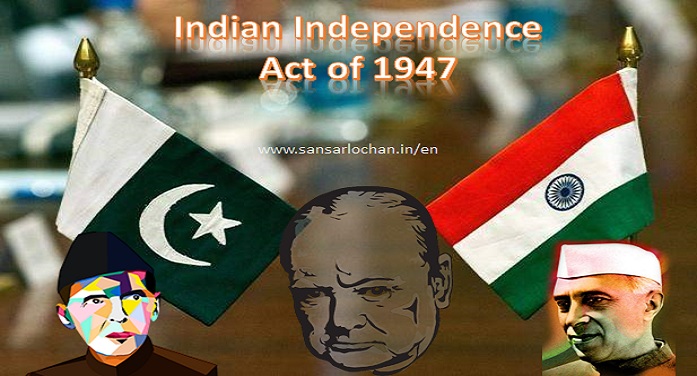The Indian Independence Act of 1947 was the last legislation of the British Parliament with the intent of creating independent India. Here through this article we are providing you a short note on 1947 Independence Act as well as a list of its provisions.
Introduction
The Government of India Act 1935 failed to satisfy the Indian demands. In 1939 the Congress reiterated its demand to form a Constituent Assembly to frame a Constitution for free India. This demand was raised by the British. With the outbreak of Second World War, the British Government sent Sir Stafford Cripps to India in 1942 when Japan just got involved in the war. The Indian National Congress was opposed to extend any help. The British realized the importance of India in combating Japan. To achieve India’s co-operation, he proposed the formation of Constituent Assembly to frame the Constitution and provide dominion status to India at the end of war. The Cripps proposals were rejected by both the Indian National Congress and the Muslim League. It led to Quit India Movement.
This was followed by Wavell Plan which proposed for re-constituting the Executive Council of the Governor General with equal seats to Hindus and Muslims. Jinnah stood for a separate Pakistan and hence declined the plan. So it failed.
Cabinet Mission Plan
In the meantime elections were held in England and Labour Party came to power with absolute majority. Clement Attlee became Prime Minister. He admitted the right of Indians to frame the Constitution for free India and even to remain out of Commonwealth. The Labour Party was earnest to solve the Indian problem. In 1946, it announced that a Cabinet Mission will be sent to India to resolve the issue. The Cabinet Mission recommended for-
- Formation of Constituent Assembly with 389 members.
- Formation of Interim Government with the support of all political parties.
- Formation of Union of India including British India and Indian states.
- Ruled out formation of Pakistan as undesirable.
As per the recommendation of the Cabinet Mission Plan, the Constituent Assembly was established presided by Dr. Babu Rajendra Prasad for making the Constitution. In 1947, Drafting Committee was set up by the Constituent Assembly under the Chairmanship of Dr.B.R. Ambedkar.
Read more about >>> Cabinet Mission Plan
Proposal rejected by Muslim League
The above proposal of Cabinet Mission was accepted by the Congress but the Muslim League rejected it. Communal riots occurred throughout the country. Finally Attlee declared the transfer of power on 20th February, 1947. The British Government sent Lord Mountbatten to transfer power to India. He held consultations with all political leaders and found that a compromise between Congress and Muslim League was impossible on the basis of United India. He achieved agreement between Congress and Muslim league on the basis of partition. The Act of 1947 (Indian Independence Act of 1947) was actually an extension of the Mountbatten plan.
Indian Independence Act of 1947
- The Indian Independence Act of 1947 provided that on 15th August, 1947, the appointed date, two independent dominions, India and Pakistan, would be set up and the Act provided for complete transfer of power.
- The dominion of India for the territory of Bombay, Madras, U.P., Central Province, Bihar, East Punjab, West Bengal, Assam, Delhi, Ajmer, Coorg etc., and the rest of India except Sindh, Baluchistan, West Punjab, East Bengal, North-West Frontier Province and Sylhet in Assam which became the territories of Pakistan. For demarcating the boundaries, Boundary Commission was formed with Sir Cyril Radcliffe as the Chairman.
- The Crown was no longer the source of authority.
- The Governor General and Provincial Governors were to act as Constitutional heads. They lost extraordinary powers to legislate.
- The office of the Secretary of State was abolished.
- From 15th of August, 1947, the British Crown lost all rights of Paramountcy over India and the Indian states were free to join either Indian Union or Pakistan.
- The power in each dominion was transferred to the Constituent Assembly which became fully sovereign from 15th August, 1947 and were absolutely free to frame the Constitution. The Constituent Assembly had a dual role i.e. Constituent and Legislative. They functioned as Central Legislature till the new legislatures were formed.
- Until the new Constitution was framed, the Act of 1935 would govern the Centre and the Provinces with necessary modifications.
Results of 1947 Act
With the passage of the Indian Independence Act of 1947, India and Pakistan became free nations. Independence of India is one of the greatest events of history. Partition was inevitable. A hard earned, prized freedom was won after long, glorious years of struggle but a tragic partition rent as under the fabric of the newly emerging free nation.
